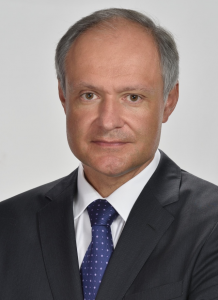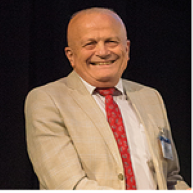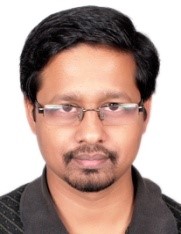 Prof. Marek Pawelczyk
Prof. Marek Pawelczyk
Vice-Rector for Science and Development, SUT / Head, Department of Measurements and Control Systems
Prof. Marek Pawelczyk is a specialist in industrial automation, signal processing, vibroacoustics and mathematical modelling. He is the author or co-author of about 250 scientific publications, 3 monographs in English, 12 national and international patent applications. He supervised 5 and was a contractor in 7 projects of the State Committee for Scientific Research (KBN), the Ministry of Science and Higher Education (MNiSW), the National Centre for Research and Development (NCBiR), the National Centre for Scientific Research (NCN), and the Horizon 2020 as well as supervised 15 industrial projects and was a contractor in 8 projects. Many of his studies have been implemented and others are at an advanced stage of commercialization.
He received his doctoral degree with distinction in 1999, his habilitation degree in 2005, from the Faculty of Automatic Control, Electronics and Computer Science, Silesian University of Technology, and the title of professor of technical sciences in 2014.
He currently holds the positions of: Vice Rector for Science and Development at the Silesian University of Technology; Head of the Department of Measurements and Control Systems at the Silesian University of Technology; Chairman of the state Committee for Science Policy at the Ministry of Education and Science, Poland; President of the International Institute of Acoustics and Vibration operating in ca. 70 countries; president of the Consortium of Silesian Public Universities; president of the Metrology Commission at the Polish Academy of Sciences, branch in Katowice; member of the Presidium of the Committee on Automation and Robotics of the Polish Academy of Sciences; vice-president of the association ProSilesia – Business, University, Region; vice-president of the College of Vice Rectors for Science and Development of Public Universities of Technology; president of the chapter of the Polish Congress Ambassadors Program; managing editor of the International Journal of Acoustics and Vibration. At the Silesian University of Technology he coordinates programmes Excellence Initiative – Research University as well as European University Eureca-Pro. For his achievements he has been repeatedly awarded by, among others: Minister of Higher Education, Polish Academy of Sciences, Foundation for Polish Science, FIAT, SIEMENS.
Innovative methods for device noise control
Noise is currently one of the most significant hazards to humans in the workplace, making it difficult to communicate by voice, to hear alarms and warnings, and being the source of many ailments and diseases, especially hearing diseases. Noise at home makes it difficult to rest and causes irritation. The most important sources of noise include equipment, both industrial and domestic. The only common way to reduce noise is to enclose the equipment and isolate in this way. The result is that many casings are extremely heavy, thick, and have insulating materials, but this results in high consumption of raw materials and also makes heat dissipation difficult. In addition, such passive methods are not very effective for low frequencies. Classical active methods of noise reduction, based on the principle of destructive interference of acoustic waves, require the use of a large number of sound sources, as well as measuring equipment, and yet they make it possible to obtain only local zones of quiet, while beyond them the sound is amplified. The research presented in this lecture proposes another, much more effective approach to reducing equipment noise – control of device casing. It has been developed in three ways. The first, is passive control, in which by attaching appropriately optimized point masses and ribs to the casing walls, it is possible to fully shape the frequency response of the structure and thus provide high isolation for noise dominant frequencies. An extension of this concept is the use of composite materials with variable properties along their cross section. In the semi-active approach, new actuators are proposed which, attached to the walls of the casing, can change their properties under the influence of the applied control and thus increase the acoustic isolation. In the active approach, exciters or piezoelectric elements are used to control the vibrations of the casing in such a way as to absorb the noise they transmit. The result of each of these approaches is a significant reduction of acoustic emission, and most importantly, it is global in space.
 Prof. Len Gelman
Prof. Len Gelman
Chair in Signal Processing and Condition Monitoring, Director, the Centre for Efficiency and Performance Engineering, UoH
Len Gelman, PhD, Dr. of Sciences (Habilitation) joined Huddersfield University as a Professor, Chair in Signal Processing/Condition Monitoring and Director of Centre for Efficiency and Performance Engineering, in 2017 from Cranfield University, where he worked as Professor and Chair in Vibro-Acoustical Monitoring since 2002.
Len developed novel condition monitoring technologies for aircraft engines, gearboxes, bearings, turbines and centrifugal compressors.
Len published more than 250 publications, 17 patents and is Co-Editor of 12 Springer books.
He is Fellow of: British Institute of NDT, International Association of Engineers and Institution of Diagnostic Engineers, Executive Director, International Society for Condition Monitoring, Editor-in-Chief, International Journal of Engineering Sciences (SCMR), Chair, annual International Condition Monitoring Conferences, Honorary Co-Chair, annual World Congresses of Engineering, Co-Chair, International Congress COMADEM 2019 and Chair, International Scientific Committee of Third World Congress, Condition Monitoring.
Len is Editorial Board member of the International Journal “Electronics”, the International Journal “Sensors”, the International Journal “Energies”, the International Journal “Insight”, the International Journal of Acoustics and Vibration, the International Journal of Prognostics and Health Management, the International Journal of Basic and Applied Sciences, the International Journal Vibration and Acoustics Research and the International Journal Signal, Image and Video Processing, Associate Editor of International Journal “Sensors”.
He was Chair, First World Congress, Condition Monitoring, Chair, Second World Congress, Engineering Asset Management and Chair, International Committee of Second World Congress, Condition Monitoring.
Len is Chair of International CM Groups of ICNDT and EFNDT and Member of ISO Technical Committee, Condition Monitoring.
Len made 42 plenary keynotes at major international conferences. He was Visiting Professor at ten Universities abroad.
Len received two Rolls-Royce (UK) Awards for Innovation, COMADIT Prize (by British Institute of NDT) for significant contribution through research/development in condition monitoring, Oxford Academic Health Science Network Award, William Smith Prize by UK Institution of Mechanical Engineers and USA Navy Award.
Novel higher order signal processing for vibration condition monitoring
The classical higher order signal processing, that are employed for condition monitoring, will be discussed. Important future directions of higher order signal processing for condition monitoring will be presented for application in transient conditions:
- new type of non-stationary adaptive spectral transforms
- new type of non-stationary non-adaptive spectral transforms
- new type of non-adaptive and adaptive frequency response functions
Validation of these novel techniques by simulation and experiments in laboratory and field conditions will also be presented.
It is shown. that the proposed transforms deliver an essential improvement in effectiveness of vibro-acoustical condition monitoring, comparing to the traditional transforms.
Gyan Ranjan Biswal
VSS University of Technology (VSSUT), India
Gyan Ranjan Biswal received his bachelor degree, B.E. in Electronics Engineering from the Pt. Ravishankar Shukla University, India in 1999 and masters’ degree, M. Tech. (Honors) in Instrumentation & Control Engineering from the Chhattisgarh Swami Vivekananda Technical University, India in 2009 followed by Ph.D. in Electrical Engineering, specialized in Power System Automation from the Indian Institute of Technology Roorkee, India in 2012.
He is experience in Design and Development of cooling systems for large size electrical generators, and the C&I of process industries. He has been in academia for more than sixteen years. Presently, he is with the VSS University of Technology, Burla, India from December 2016 as an Associate Professor where, presently, he holds the responsibility of HOD, EEE department. He has more than 70 publications in various Journals and Conferences of Internationally reputed to his credit. He also holds three patents, and adapted one international edition book published by Pearson India. He received research grants of US$90,000 (INR 53 lakhs). He has supervised 01 PhD, 09 Masters’ theses, and ongoing 04 PhD theses. He has been awarded the CICS award under the head of Indian National Science Academy, MHRD Fellowship by Govt. of India, and Gopabandhu Das Scholarship in his career. His major areas of interests are Power System and Industrial Automation, Smart Sensors, IoT enabled Smart Sensors, and Fuel Cell backed Sustainable Sources of Energy.
Dr. Biswal is a Fellow of the IE (India), Senior Member of IEEE, USA, and Life Member of ISTE, India. He is actively involved in review panels of different societies of international repute viz. IEEE, IFAC, and the ISA. Currently, he is also actively involved as a Member of IEEE–SA (Standards Association) working groups; IEEE P1876, IEEE P21451-001, IEEE P1415, IEEE P1451.5, and IEEE PC37.1.3. He has also been invited to deliver guest lectures at several national and international forums, namely, World Congress on Sustainable Technologies (WCST) Conf. 2012, London, UK, INDICON 2015, New Delhi, India, National Power Training Institute (NPTI), Nangal, India, and G.B. Pant Engineering College, Pauri, Gharwal, India, VSS University of Technology (VSSUT), Burla, guest expert in 2016 IEEE PES General Meeting Boston, MA, USA, NPTI Durgapur in 2019, Chhattisgarh Council of Science & Technology (CCOST) at BIT Durg in 2019, and NPTI, Shivpuri in 2021.
Smart Sensor and IoT for Smart Grid-and-Smart City Applications
In this talk, I would like to emphasize the greater and increasing role of IoT enabled smart sensors in our daily life; an effort to make our existing electricity grid smarter or establishing all together a new Smart Grid, and thereby, making our city life even smarter, popularly recognized as Smart Cities. First, I’ll discuss a new age designed smart gas density sensor and humidity sensors, primarily fabricated for IEC 61850 compliant sub-stations. While; secondly, I shall focus on a new age device known as “Smart Plugs” which is soon going to be an essential component of a Smart Home or a Smart Building.
- Smart Sensors for the optimal operations of gas insulated switchgears: A direct measurement of humidity inside the Sulphur hexafluoride (SF6) – gas insulated switchgear (GIS), and early detection of leakages of gas from GIS vessels is always challenging. In this regard, fabrication of low-cost, high linear response and high precision sensors are always exciting. SF6 over air as a medium is preferred in GIS because of its improved specific heat and arc-quenching capabilities in the closed environment. SF6 is an inert gas, however, its leakage causes 22,800 times more impact on the environment over greenhouse gases emissions. Typically pressure inside the vessel is maintained at 1.2 Bar and above in GIS. Here, I’ll throw some light on the investigation needed for the availability or design of a humidity sensor that can detect the minimal concentration of humidity, close to 0-2%-RH / 0- 491 ppm-v scale with high sensitivity. Further, detection of gas-leakage inside the SF6-GIS environment engenders precarious damage to the live conductors and some electrical equipment. Especially, measuring equipment and protection mechanisms beneath the vessel can critically affect the time of switching where gas leakage is encountered. These actions are to be closely observed by advanced automation systems as per IEC 61850 and IEEE 1686 protocols. Thus, it is indispensable to place a high precision Gas Density Sensor (GDS) that can measure the leakage of SF6 Gas inside the vessel at PPM/Trace-level with leakages less than 0.5% per annum rate. The recent findings shows that ultrasonic sensor is one of the most suitable options to fabricate a cost-effective, high performance gas density sensor.
- Smart Plugs to enable a smarter home: In the current energy ecosystem, the need for a Hybrid Appliance Load Monitoring System (HALMS) to establish a smarter grid and energy infrastructure is undeniable. The increasing popularity of the Internet of Things (IoT) has suddenly pushed the demand for smart and connected devices. The smart plugs are a handy solution to make the so-called ‘dumb’ devices smart. The strategy of smart plugs to enhance the energy management experience in connected spaces is presented. We have patented a design of a novel Smart Plug which can remotely control the speed of high power-high current consuming electronic domestic appliances using low-cost communication protocol. These plugs provide you an age to not only monitor your home appliances remotely using Internet of Things (IoT) but also you have an option to control certain operations of dedicated appliances at your home or the power supply network of the house or building.
Overall, both the interconnected segments are pushing towards design and fabrication of “IoT Enabled Smart Sensors” over a single substrate, and is one of the emerging R&D activities in the domain areas.


